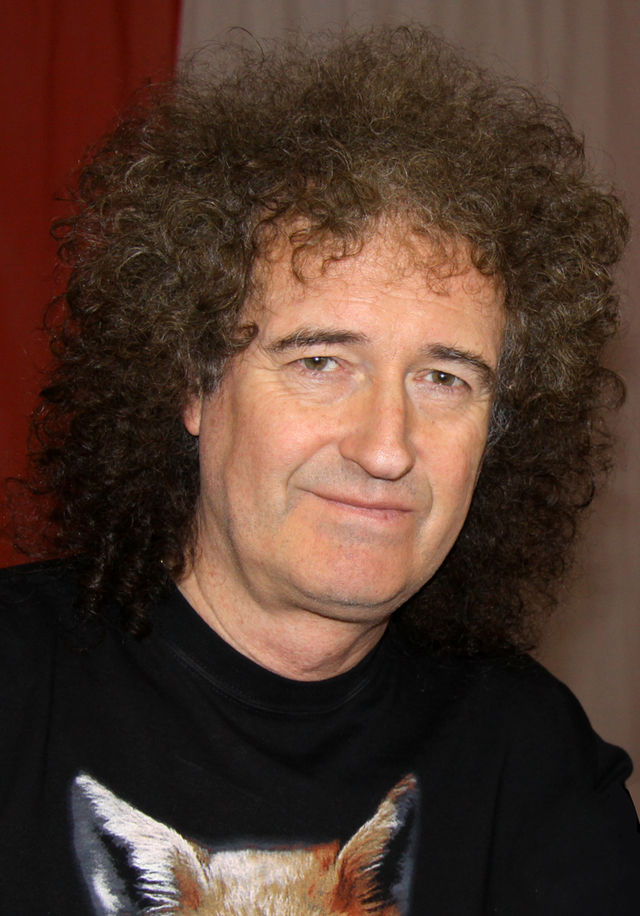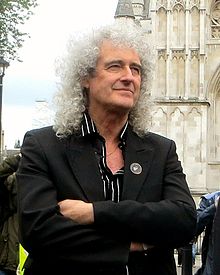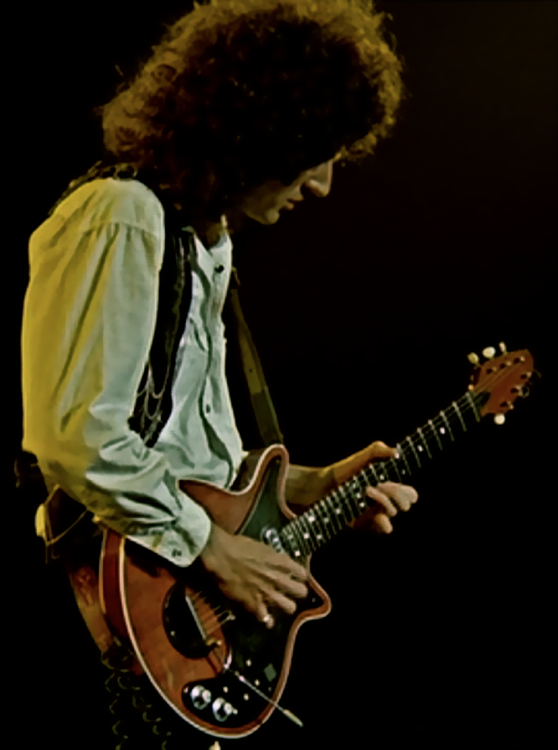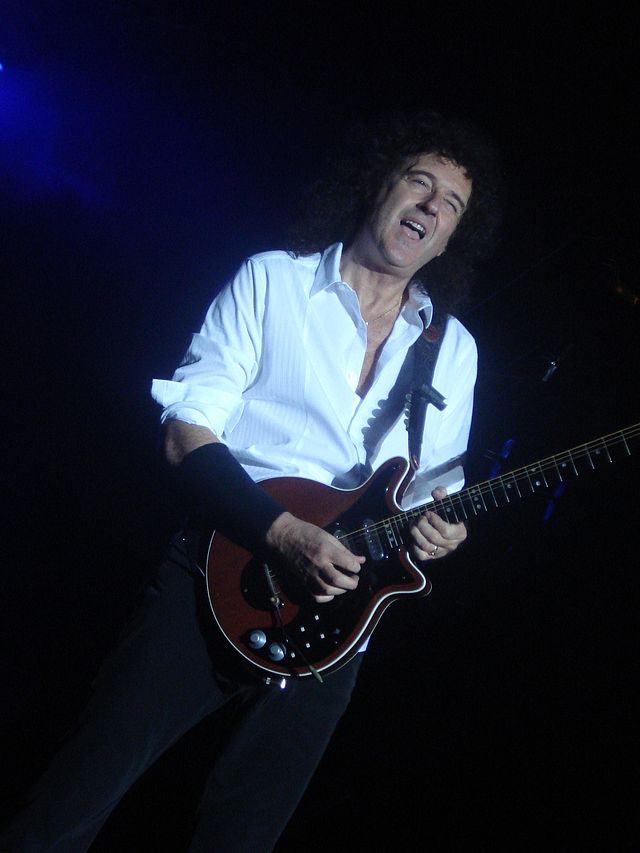BIOGRAPHICAL DETAILS
Full Name: Brian Harold May
Description: Guitarist, Composer, UK
Known For: Known as the lead guitarist in the rock band Queen.
He was ranked as the 39th greatest guitarist of all time
Instruments: Guitar
Music Styles: Hard Rock
Location: United Kingdom
Date Born: 19th July 1947
Location Born: Hampton, United Kingdom
Photo Comments: This file is licensed under the Creative Commons Attribution ShareAlike 2.5 License. In short: you are free to share and make derivative works of the file under the conditions that you appropriately attribute it.
CONTACT DETAILS
Web Site: Brian May’s official homepage
BRIANMAY.COM || THE OFFICIAL BRIAN MAY WEBSITE
YOUTUBE VIDEO
BIOGRAPHICAL PROFILE
Brian May CBE
Brian Harold May CBE (born 19 July 1947) is an English musician, singer, songwriter and astrophysicist who achieved international fame as the lead guitarist of the rock band Queen. He uses a home-built guitar, the Red Special. His compositions for the band include “We Will Rock You”, “Tie Your Mother Down” and “Fat Bottomed Girls”.
He was appointed a Commander of the Most Excellent Order of the British Empire (CBE) in 2005 for “services to the music industry and for charity work”. May attained a PhD in astrophysics from Imperial College in 2007 and was Chancellor of Liverpool John Moores University from 2008 to 2013. He has homes in London and Windlesham, Surrey. He is an active animal rights advocate and was appointed a vice-president of animal welfare charity the RSPCA in September 2012.
In 2005, a Planet Rock poll saw May voted the 7th greatest guitarist of all time. He was ranked at No. 26 on Rolling Stone magazine’s list of the “100 Greatest Guitarists of All Time”. In 2012, May was ranked the 2nd greatest guitarist of all time by a Guitar World magazine readers poll.
Brian May, the only child of Harold and Ruth May, was born in Hampton, London and attended the local independent school for boys, Hampton Grammar School (now Hampton School). During this time he formed his first band with vocalist and bassist Tim Staffell, named 1984 after George Orwell’s novel of the same name. At Hampton Grammar School, he attained ten GCE Ordinary Levels and three A-Levels (Physics, Mathematics and Applied Mathematics). He studied Mathematics and Physics at Imperial College London, graduating with a BSc. degree.
Musical career
1968–1970: Smile
Main article: Smile (band)
Brian May formed the band Smile in 1968. The group included Tim Staffell as singer and bassist, and later, drummer Roger Taylor, who also went on to play for Queen. The band lasted for two years from 1968 to 1970, as Staffell left in 1970, leaving the band with a catalogue of nine songs. Smile would reunite for several songs on 22 December 1992. Taylor’s band The Cross were headliners and he brought May and Staffell on to play “Earth” and “If I Were a Carpenter”. May also performed several other songs that night.
1970–1991: Queen
May also served as Queen’s backing vocalist. In Queen’s three-part vocal harmonies, May was generally the lower-range backing vocals. On some of his songs he sings the lead vocals, most notably the first verse of “Who Wants to Live Forever”, the bridge on “I Want It All” and “Flash’s Theme”, and full lead vocals on “Some Day One Day”, “She Makes Me (Stormtrooper in Stilettoes)”, “’39”, “Good Company”, “Long Away”, “All Dead, All Dead”, “Sleeping on the Sidewalk”, “Leaving Home Ain’t Easy” and “Sail Away Sweet Sister”.
Throughout Queen’s career May frequently wrote songs for the band and has composed many significant songs such as the worldwide hit “We Will Rock You”, as well as “Tie Your Mother Down”, “Who Wants to Live Forever”, “Brighton Rock”, “The Prophet’s Song”, “Hammer to Fall”, “Save Me”, “Fat Bottomed Girls”, “Flash”, “Now I’m Here”, and “I Want It All”. Typically, either Freddie Mercury or May wrote the most songs on every Queen album.
After the famous Live Aid concert in 1985, Mercury rang his band members and proposed writing a song together. The result was “One Vision”, which was basically May on music (the Magic Years documentary shows how he came up with the opening section and the basic guitar riff) and the lyrics were co-written by all four band members.
For their 1989 release album, The Miracle, the band had decided that all of the tracks would be credited to the entire band, no matter who had been the main writer. Still, interviews and musical analyses tend to help identify the input of each member on each track. May composed “I Want It All” for that album, as well as “Scandal” (based on his personal problems with the British press). For the rest of the album he did not contribute so much creatively, although he helped in building the basis of “Party” and “Was It All Worth It” (both being predominantly Mercury’s pieces) and created the guitar riff of “Chinese Torture”.
Queen’s subsequent album was Innuendo, on which May’s contributions increased, although more in arrangements than actual writing in most cases; for the title track he did some of the arrangement for the heavy solo, then he added vocal harmonies to “I’m Going Slightly Mad” and composed the solo of “These Are the Days of Our Lives”, a song for which the four of them decided the keyboard parts together. He changed the tempo and key of Mercury’s song “The Hitman” and took it under his wing, even singing guide vocal in the demo. May also co-wrote some of the guitar lines in “Bijou”.
Two songs that May had composed for his first solo album, “Headlong” and “I Can’t Live With You”, eventually ended up in the Queen project. His other composition was “The Show Must Go On”, a group effort in which he was the coordinator and primary composer, but in which they all had input, Deacon and Taylor with the famous chord sequence. In recent years, he has supervised the remastering of Queen albums and various DVD and greatest hits releases. In 2004, he announced that he and drummer Roger Taylor were going on tour for the first time in 18 years as “Queen”, along with Free/Bad Company vocalist Paul Rodgers. Billed as “Queen + Paul Rodgers”, the band has played throughout 2005 and 2006 in South Africa, Europe, Aruba, Japan, and North America and released a new album with Paul Rodgers in 2008, entitled The Cosmos Rocks. This album was supported by a major tour.
1983–1998: the Brian May band
During 1983, several members of Queen explored side projects. On 21 and 22 April in Los Angeles, May recorded his first solo work, a mini-album entitled Star Fleet Project, on which he collaborated with Eddie Van Halen. May contributed to former Genesis guitarist Steve Hackett’s album Feedback 86, playing guitar on the track “Cassandra” and providing guitar and vocals for “Slot Machine”. “Slot Machine” was also co-written by May.
May worked with his second wife Anita Dobson on her first album, in which she sang vocals to the EastEnders theme tune. In this form the tune became the song “Anyone Can Fall in Love”. May himself produced the song, which reached No. 4 in the UK Singles Chart in August 1986. In 1989, May contributed guitar solos to the song “When Death Calls” on Black Sabbath 14th album Headless Cross, and the Living in a Box track “Blow The House Down” from the album Gatecrashing.
Following the death of Freddie Mercury in November 1991, May booked himself into a clinic in Arizona, and states; “I regarded myself as completely sick. I was wounded and very much in pieces. I went into a serious depression. I was subsumed by feelings of loss.” He chose to deal with his grief by committing himself as fully as possible to work, first by finishing his solo album, Back to the Light, and then touring worldwide to promote it. He frequently remarked in press interviews that this was the only form of self-prescribed therapy he could think of.[20] According to Def Leppard vocalist Joe Elliot, “It was undoubtedly an enormous and terrible blow to lose someone he was so close to. Personally, I know it ripped the heart out of Brian, but having said that, he was in great spirits after the album was finished.”
In late 1992, the Brian May Band was officially formed. An early version of the band was loosely formed for 19 October 1991, the date of the band’s last concert of reunion.October 1991, when May took part in the Guitar Legends guitar festival in Seville, Spain. The line-up for his performance was May on vocals and lead guitar, Cozy Powell on drums and percussion, Mike Moran and Rick Wakeman on keyboards, and Maggie Ryder, Miriam Stockley and Chris Thompson on backing vocals. The original line-up was May on vocals and lead guitar, Powell on drums and percussion, Michael Casswell on guitar, Neil Murray on bass, and Ryder, Stockley and Thompson on backing vocals. This version of the band lasted only during the South American support tour (supporting The B-52’s and Joe Cocker) on only five dates.
Afterwards, May made significant changes, feeling the group never quite gelled. May brought guitarist Jamie Moses on board to replace Mike Caswell. The other change made was in the backing vocals department, when Ryder, Stockley and Thompson were replaced with Catherine Porter and Shelley Preston. On 23 February 1993, this new line-up of The Brian May Band began its world tour in the US, both supporting Guns N’ Roses and headlining a few dates. The tour would take them through North America, Europe (support act: Valentine) and Japan. After the tour ended on 18 December 1993, May returned to the studio with fellow surviving Queen band members Roger Taylor and John Deacon to work on tracks that became Made in Heaven, the final Queen studio album. The band took Mercury’s solo album demos and last recordings, which he managed to perform in the studio after the album Innuendo was finished, and completed them with their additions both musically and vocally. Work on the album after Mercury’s death originally began in 1992 by Deacon and May, but was left until a later date due to other commitments.
In 1995, May began working towards a new solo album of covers tentatively named Heroes, in addition to working on various film and television projects and other collaborations. May subsequently changed the approach from covers to focus on those collaborations and on new material. The songs included Another World, and featured mainly Spike Edney, Cozy Powell, Neil Murray and Jamie Moses. On 5 April 1998, Cozy Powell was killed in a car accident on the M4 motorway near Bristol, England. This caused a huge, unexpected disruption to the upcoming tour for The Brian May Band, with a new drummer being needed at short notice. Steve Ferrone was brought on to help May finish recording drums and to join the band for the early stage promotional tour of five dates in Europe before the world tour. Following the early promotional tour, Eric Singer replaced Steve Ferrone for the full 1998 world tour.
From his last solo release in 1998 May has been performing as a solo artist, as part of an ensemble, and infrequently as Queen with Roger Taylor. On 22 October 2000, Brian May made a guest appearance at the Motörhead 25th Anniversary show at Brixton Academy along with Eddie Clarke (former Motörhead guitarist) for the encore song “Overkill”. In the Queen’s birthday honours list of 2005, he was made a Commander of the Order of the British Empire “for services to the music industry”. May is a friend of singer and musician Phil Collins and was a special guest at the Genesis reunion concert at Twickenham Stadium in 2007.
Other instruments
The first instrument May learned to play was the banjolele, which he played on Queen’s song “Bring Back That Leroy Brown” (live and in the studio). For “Good Company”, he used a regular baritone ukulele which he had bought in Hawaii on a holiday. Occasionally, May would also record on other string instruments such as harp (one chord per take, then copied and pasted by the engineer to make it sound like a continuous performance) and bass (on some demos and many songs in his solo career, and the Queen + Paul Rodgers album).
As a child, he was also trained on classical piano. Although Freddie Mercury was the band’s primary pianist, May would occasionally step in (such as on “Save Me”, “Flash”, “Who Wants To Live Forever”). From 1979 onwards, he also played synthesisers, organ (“Wedding March”, “Let Me Live”) and programmed drum-machines for both Queen and outside projects (such as producing other artists and his own solo records).
May is also an accomplished singer. From Queen’s Queen II to The Game, May contributed lead vocals to at least one song per album. May co-composed a mini-opera with Lee Holdridge, Il Colosso, for Steve Barron’s 1996 film, The Adventures of Pinocchio. May performed the opera with Jerry Hadley, Sissel Kyrkjebo, and Just William. On-screen, it was performed entirely by puppets.
Most of May’s electric guitar work live and in the studio was done on the Red Special, which he built with his father, and electronics engineer, during his teenage years. From 1975 onwards, he has also had some replicas made, some of which were also used for live and recording purposes, others were mainly spares. The most famous replicas were made by John Birch (in 1975—May actually smashed it during a concert in the States in 1982), Greco BM90 (featured in the promo video of “Good Old-Fashioned Lover Boy” in 1977), Guild (back-up from 1984 to 1993), Fryers (1997–1998, used both live and in the studio) and Guyton (back-up from 2003 to present). On stage, May used to carry at least one back-up guitar (in case he broke a string) and occasionally would use others for certain songs or parts, such as alternate tunings. Currently, May owns a company which makes guitars whose design is modelled after the original Red Special guitar.
July 1973 – May 1974: Fender Stratocaster Pre-CBS
October 1974 – May 1975: Gibson Les Paul Deluxe, and the Stratocaster from the previous tour.
November 1975 – May 1976: Same two guitars as before, plus a natural finish John Birch replica of the Red Special.
September 1976: Same three as before, plus a Martin D-18 acoustic for “’39”.
January 1977 – August 1979: Just the Birch replica plus an Ovation Pacemaker 12-string acoustic on some numbers (“’39”, “Love of My Life”, “Dreamer’s Ball”).
November 1979 – June 1982: Birch replica (back-up), Fender Telecaster (“Crazy Little Thing Called Love” 2nd verse, middle-eight and solo), Ovation (acoustic numbers).
July – November 1982: Added a Gibson Flying V as second back-up. On 9 August 1982 Brian smashed the Birch guitar, so the Flying V became the only spare.
August – October 1984: The Flying V became a second back-up again as his main spare was the Guild replica. He also used Roger Taylor’s Gibson Chet-Atkins Classical Electric.
July 1985 – August 1986: Gibson Flying V no longer used. The rest remained the same.
In 2012 he received a double-neck replica of the Red Special with the second neck having 12-strings. He used this guitar at a few gigs with Adam Lambert now being able to play the 12-string part from the studio version of Under Pressure live.
He currently has a Guild 12-string to replace his Ovation Pacemaker. Some of the non-RS electric guitars he used in the studio included:
Burns Double Six on “Long Away” (1976) and “Under Pressure” (1981).
Fender Telecaster on “Crazy Little Thing Called Love” (1979). It was used for the video (but not the recordings) of “Back Chat” (1982).
Gibson Firebird on “Hammer to Fall” and “Tear It Up” (album versions only, not on stage).
Ibanez JS on “Nothing But Blue” (1991).
Parker Fly on “Mother Love” (1993–1995).
For acoustic, he favoured Ovation, Martin, Tōkai Hummingbird, Godin and Guild. On a couple of videos he also used some different electric guitars: a Stratocaster copy on “Play the Game” (1980) and a Washburn RR2V on “Princes of the Universe” (1986).
In 1984 Guild released the first official Red Special replica for mass production, and made some prototypes specifically for May. However the solid body construction (the original RS has hollow cavities in the body) and the pick-ups (DiMarzio) that were not an exact replica of the Burns TriSonic did not make May happy, so the production stopped after just 300 guitars. In 1993 Guild made a second replica of the RS, made in just 1000 copies, of which May has some and used as a back-up. At the moment, he uses the two guitars made by Greg Fryer—the luthier who restored the Old Lady in 1998—as back-up. They are almost identical to the original, except for the Fryer logo on the headstock (May’s original one has a sixpence).
In the studio, May used Yamaha DX7 synths for the opening sequence of “One Vision” and the backgrounds of “Who Wants to Live Forever” (also on stage), “Scandal” and “The Show Must Go On”. He mostly used Freddie Mercury’s 1972 Steinway piano and reportedly now owns the instrument in question. May was keen on using some toys as instruments as well. He used a Yamaha plastic piano in “Teo Torriatte” and a toy mini koto in “The Prophet’s Song”. He also used a “genuine George Formby Ukulele-Banjo” in “Bring Back That Leroy Brown” and “Good Company”
Amplifiers and effects
May has used Vox AC30 amplifiers almost exclusively since a meeting with his long-time hero Rory Gallagher at a gig in London during the late 1960s/early 1970s. In the mid-1970s he used six of them, with an Echoplex delay (with extended delay time) plugged into a separate amplifier, and a second Echoplex plugged into yet another amp; he used a homemade booster, his only effects pedal, which was on all the time. His choice is the model AC30TBX, the top-boost version with Blue Alnico speakers, and he runs the amp at full volume on the Normal channel. He also customises his amps by removing the circuitry for the Brilliant and Vib-trem channels (leaving only the circuitry for the Normal), and this alters the tone slightly, with a gain addition of 6–7 dB. He always used a treble booster which, along with the AC30 and his custom ‘Deacy Amp’ transistor amp, was built by Queen bass player John Deacon, went a long way in helping to create many of his signature guitar tones. He used the Dallas Rangemaster for the first Queen albums, up to A Day at the Races. Effects guru Pete Cornish built for him the TB-83 (32 dB of gain) that was used for all the remaining Queen albums. He switched in 2000 to the Fryer’s booster, which actually gives less boost than the TB-83.
When performing live, he uses banks of Vox AC30 amplifiers keeping some amps with only guitar and others with all effects such as delay, flanger and chorus. He has a rack of 14 AC30s, which are grouped as Normal, Chorus, Delay 1, Delay 2. On his pedal board, May has a custom switch unit made by Cornish and subsequently modified by Fryer that allows him to choose which amps are active. He uses a BOSS pedal from the ’70s, the Chorus Ensemble CE-1, which can be heard in “In The Lap of The Gods” (Live at Wembley ’86) or “Hammer to Fall” (slow version played live with P. Rodgers). Next in the chain, he uses a Foxx Foot Phaser (“We Will Rock You”, “We Are the Champions”, “Keep Yourself Alive”, etc.), and two delay machines to play his trademark solo in “Brighton Rock”.
Personal life
From 1974 to 1988, May was married to Chrissie Mullen, who is the mother of his three offspring: Jimmy, born on 15 June 1978; Louisa, born on 22 May 1981 and Emily Ruth, born on 18 February 1987. May and Chrissie separated in 1988. Their separation and eventual divorce was publicised by British tabloid newspapers following reports that he had an affair with EastEnders actress Anita Dobson, whom he met in 1986, and who gained fame in the 1980s as Angie Watts. After a concert at Wembley Stadium, she inspired him to write the 1989 hit “I Want It All”. They married on 18 November 2000.
He has stated in interviews that he suffered from severe depression in the late 1980s and early 1990s, to the point of contemplating suicide, for reasons having to do with his troubled first marriage, his perceived failure as a husband and a father, his father Harold’s death and Freddie Mercury’s illness and death.
May’s father Harold worked as a draughtsman at the Ministry of Aviation and was a long-time heavy cigarette smoker. As a result, May dislikes smoking, even to the point where he has prohibited smoking indoors at his more recent concerts. His father was disappointed that he abandoned his scientific education to become a rock musician, but after May flew both his parents to New York to attend Queen’s first concert in Madison Square Garden, his father said that he “got it”.[According to The Sunday Times Rich List he is worth £85 million or around $135 million as of 2011.
Brian May is a vegetarian.
From Wikipedia, the free encyclopedia




